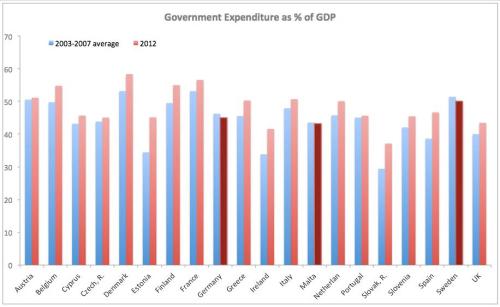National defense is one of the few legitimate functions of the federal government, but that doesn’t mean the military should get a blank check to spend unlimited amounts of money.
To make sure taxpayers get the best bang for the buck (no pun intended), there should be a sober assessment of threats to national security and a plan to defend against those threats without adding superfluous expenditures.
 That being said, America already accounts for close to 50 percent of world military spending, with another 25 percent of the global total coming from nations that are allied to the United States, so I’m fairly confident that we’re not under-spending on the Pentagon.
That being said, America already accounts for close to 50 percent of world military spending, with another 25 percent of the global total coming from nations that are allied to the United States, so I’m fairly confident that we’re not under-spending on the Pentagon.
That’s one of the reasons I don’t worry that much about the sequester, particularly since military spending actually climbs by about $100 billion over the next 10 years.
But I would like the Defense Department to have some flexibility to reallocate funds so that we spend money on national security rather than boondoggles.
And there are some absurd examples of waste at the Pentagon, including “green” jet fuel that costs 15 times as much as regular fuel. Here are some of the mind-boggling details from the Washington Examiner.
Defense Secretary Chuck Hagel recently warned that sequestration would cause “suspension of important activities, curtailed training, and could result in furloughs of civilian personnel” but the spending cuts haven’t killed the green fuels program, as the Pentagon has continued purchasing renewable fuel at $59 per gallon. “In March, Gevo entered into a contract with the Defense Logistics Agency to supply the U.S. Army with 3,650 gallons of renewable jet fuel to be delivered by the second quarter of 2013,” Gevo announced this week in its first quarter financial report. “This initial order may be increased by 12,500 gallons.
This is even worse than the bizarre $600,000 frog statue than the Defense Department selected to adorn a new $700 million office building.
 I realize that the $700 million office building should be the bigger issue, but I can’t help but be irked by the thought that taxpayers are being raped and pillaged for the frog.
I realize that the $700 million office building should be the bigger issue, but I can’t help but be irked by the thought that taxpayers are being raped and pillaged for the frog.
In any event, the $700 million for the office building is pocket change compared to the amount of money we misallocate to subsidize Western Europe to protect against a Warsaw Pact military alliance that no longer exists!
Yes, it’s true that America’s main fiscal problem is entitlement spending. And, yes, domestic discretionary spending is a bigger problem than the defense budget.
But wasting money in those areas is not a reason to also have waste at the Pentagon.

